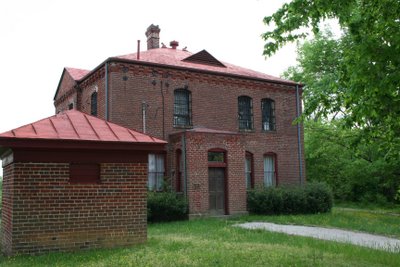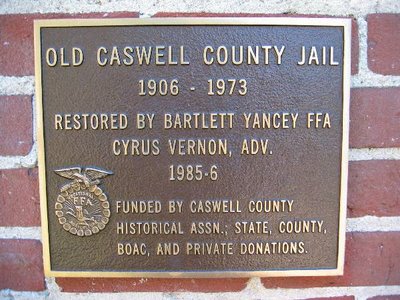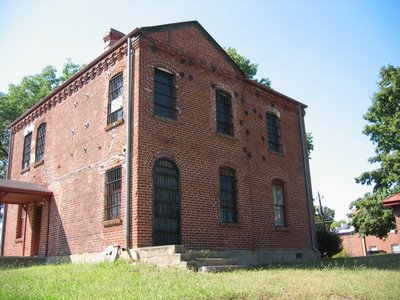
Caswell County Jail
One of the most interesting buildings in Caswell County is the old Caswell County Jail. Built in the first decade of the 1900's, the Jail served the county's prisoner housing needs until 1973, when a new jail was constructed.
After 1973, the old jail was used for a variety of short-term purposes, but by and large, the building stood unused, neglected, and empty. The ravages of time, weather, and lack of maintenance began to tell on the old structure, which soon developed symptoms of severe deterioration.
Newspaper Article: The Danville Register (Danville, Virginia) 19 December 1972. Click the article to see a larger version.
In 1985, the Caswell County Historical Association negotiated a 25-year lease on the building from the County Commissioners. The Bartlett Yancey Future Farmers of America Chapter was enlisted to renovate the structure, repair damage, and restore the building as near as possible to its original condition. One hundred and thirty members of the Chapter volunteered over 6,300 person-hours to the project, with donations of time, equipment, and materials by a number of Caswell County businesses and residents.
One of the first measures taken by the FFA was to demolish a boiler room and a women's cell block that had been added to the building, and which were not part of the original architecture. Broken windows that had allowed the elements inside were replaced, and damaged interior structures were removed in preparation for the renovation.
Rotted flooring was replaced with new wood, donated for the cause by a local resident. Students spent hours patching holes in the walls and ceilings. The many layers of paint that covered much of the inside were laboriously removed. The exterior of the building received significant attention, with students replacing damaged brickwork and repairing and repainting the tin and shingled roof. Throughout the renovation project, the original architectural design of the old Jail building was closely followed.
As a result of the many hours of work volunteered by the FFA Chapter, visitors to the old Jail today can see how it looked in its early years of use. Adding to the authenticity of the Jail are many pieces of period furnishings loaned and donated by the County and local residents.

The old Caswell County Jail is a two-story structure with the cell block located on the upper floor and reached through a heavy steel door at the rear corner of the building.

The cells have been left very nearly in the condition they were in when the renovation project began, with the cold steel walls covered with years of graffiti, the artwork and philosophy of the countless prisoners housed there.
The lower floor served as quarters for the jailer (and often the sheriff filled the job as jailer) and his family and consisted of a foyer, three rooms, and a kitchen (where meals for the jailer and his prisoners were prepared).
One of the most interesting aspects of the Jail is the indoor hanging cell. When the Jail was built executions in North Carolina were handled at the county level, and the indoor hanging cell was included in the design of the Jail apparently to provide for such executions. However, soon after the Jail was completed responsibility for executions was assumed by the State; and there is no record of anyone meeting the final fate by way of the trap door in the upper-floor cell. Later, the space below the hanging cell was used to hold female prisoners (until a separate cell block for women was added in the 1950's).
Caswell County Trivia: While the old Caswell County Jail has a built-in gallows for hanging, no one was hanged there. However, there was an attempted hanging in July 1974, when nineteen-year-old jail inmate Ralph Johnson of Burlington attempted to hang himself using bunk sheets.

If you have stories about this old Jail (hopefully not as a result of an over-night stay), please share them. Photographs are always welcome -- like the one below from the 1960's:

_______________
Several Caswell County jails apparently preceded the one described above. Presumably, there was some sort of jail associated with the initial Caswell County Courthouse in Leasburg. An early reference is found in the minutes of the Caswell County Court of Pleas and Quarter Sessions during its January 1786 session: "The Sheriff objects to the Sufficiency of the Jayel." This objection was repeated during the next session of the court (April 1786). No further details of this jail are known.
However, the court eventually responded to the sheriff's objections. During its January 1789 session the court named a committee to "build a gaol and to have two gates put to the barn and that the Court House be put in repair." During the April session, the court "laid out prison bounds to public lots." And, during the January 1790 session the court reported: "Commission received the public gaol from William Rainey as it was completed."
Query what the first sheriff did with those he arrested before the Leasburg jail was built. David Shelton was appointed Caswell County Sheriff in 1777. Was there no jail between 1777 and 1790?
But, the Caswell County sheriff apparently was not yet satisfied. Court minutes for the October 1790 session show that: "Thomas Brooks, sheriff, objects to sufficiency of the jail." At its October 1791 session, the court ordered the "courthouse and jail to be repaired." However, the sheriff continued to object to the jail's sufficiency. This became moot when in 1792 Person County was created from Caswell County and the Caswell County seat of government moved to what would become Yanceyville. The courthouse and jail in Leasburg were sold.
A new jail at Caswell Court House (Yanceyville) was first mentioned in the court minutes for the April 1794 session: "Ordered that William Sawyer be paid 15 lbs. in part of building the gaol." But, as of early 1797 no jail apparently had been built. The court minutes for the January 1797 session show: "Work to begin on gaol as 200 pounds was in hands of commissioner." The jail must have been completed by mid-year 1797 as court minutes for the April 1797 session which ran April through June provided: "John Yancey to get door of gaol mended and repair and procure a good lock." Later that year, John Yancey was paid 40 shillings for having jail door repaired.
At its January 1798 session the court "ordered old jail sold." Which jail is uncertain. Was this the original jail in Leasburg, or had their been an earlier jail in Yanceyville?
April 1801: "Reported that Thomas Haralson would repair gaol for 14 lbs. 19 shs. and would repair court house for 27 lbs 14 shs."
October 1806: "Capt. John Graves to be paid 75 pounds for repairing gaol."
January 1812: "Solomon Graves, Treasurer of publick buildings, reported the jail in unfit situation to retain prisoners. Court ordered Thomas donoho, John Stamps, Philip Pearce, Solomon Debow, Alex. Murphey, James Yancey, Bartlett Yancey, and Jesse Carter to examine and draw plans for repairs."
April 1812: "Ordered that Maj. Thomas Donoho, Jesse Carter, John Stamps, William Rainey, James Yancey, Capt. Solomon Graves and William Graves contract with persons to build one additional room to jail and to make other repairs."
"On April 14, 1812, John Stamps and Thomas Donoho reported for jail commission: would be necessary to build a room fronting the jail door 16 by 14 ft. with a chimney of stone or brick for the purpose of a jailor's room."
October 1813: "265 pounds, and 10 shillings paid for repairs at jail."
July 1818: "Jailor paid 40 cents per prisoner per day."
_______________
North Carolina County Prisons in 1908
In 1985, the Caswell County Historical Association negotiated a 25-year lease on the building from the County Commissioners. The Bartlett Yancey Future Farmers of America Chapter was enlisted to renovate the structure, repair damage, and restore the building as near as possible to its original condition. One hundred and thirty members of the Chapter volunteered over 6,300 person-hours to the project, with donations of time, equipment, and materials by a number of Caswell County businesses and residents.
One of the first measures taken by the FFA was to demolish a boiler room and a women's cell block that had been added to the building, and which were not part of the original architecture. Broken windows that had allowed the elements inside were replaced, and damaged interior structures were removed in preparation for the renovation.
Rotted flooring was replaced with new wood, donated for the cause by a local resident. Students spent hours patching holes in the walls and ceilings. The many layers of paint that covered much of the inside were laboriously removed. The exterior of the building received significant attention, with students replacing damaged brickwork and repairing and repainting the tin and shingled roof. Throughout the renovation project, the original architectural design of the old Jail building was closely followed.
As a result of the many hours of work volunteered by the FFA Chapter, visitors to the old Jail today can see how it looked in its early years of use. Adding to the authenticity of the Jail are many pieces of period furnishings loaned and donated by the County and local residents.

The old Caswell County Jail is a two-story structure with the cell block located on the upper floor and reached through a heavy steel door at the rear corner of the building.

The cells have been left very nearly in the condition they were in when the renovation project began, with the cold steel walls covered with years of graffiti, the artwork and philosophy of the countless prisoners housed there.
The lower floor served as quarters for the jailer (and often the sheriff filled the job as jailer) and his family and consisted of a foyer, three rooms, and a kitchen (where meals for the jailer and his prisoners were prepared).
One of the most interesting aspects of the Jail is the indoor hanging cell. When the Jail was built executions in North Carolina were handled at the county level, and the indoor hanging cell was included in the design of the Jail apparently to provide for such executions. However, soon after the Jail was completed responsibility for executions was assumed by the State; and there is no record of anyone meeting the final fate by way of the trap door in the upper-floor cell. Later, the space below the hanging cell was used to hold female prisoners (until a separate cell block for women was added in the 1950's).
Caswell County Trivia: While the old Caswell County Jail has a built-in gallows for hanging, no one was hanged there. However, there was an attempted hanging in July 1974, when nineteen-year-old jail inmate Ralph Johnson of Burlington attempted to hang himself using bunk sheets.

If you have stories about this old Jail (hopefully not as a result of an over-night stay), please share them. Photographs are always welcome -- like the one below from the 1960's:

_______________
Several Caswell County jails apparently preceded the one described above. Presumably, there was some sort of jail associated with the initial Caswell County Courthouse in Leasburg. An early reference is found in the minutes of the Caswell County Court of Pleas and Quarter Sessions during its January 1786 session: "The Sheriff objects to the Sufficiency of the Jayel." This objection was repeated during the next session of the court (April 1786). No further details of this jail are known.
However, the court eventually responded to the sheriff's objections. During its January 1789 session the court named a committee to "build a gaol and to have two gates put to the barn and that the Court House be put in repair." During the April session, the court "laid out prison bounds to public lots." And, during the January 1790 session the court reported: "Commission received the public gaol from William Rainey as it was completed."
Query what the first sheriff did with those he arrested before the Leasburg jail was built. David Shelton was appointed Caswell County Sheriff in 1777. Was there no jail between 1777 and 1790?
But, the Caswell County sheriff apparently was not yet satisfied. Court minutes for the October 1790 session show that: "Thomas Brooks, sheriff, objects to sufficiency of the jail." At its October 1791 session, the court ordered the "courthouse and jail to be repaired." However, the sheriff continued to object to the jail's sufficiency. This became moot when in 1792 Person County was created from Caswell County and the Caswell County seat of government moved to what would become Yanceyville. The courthouse and jail in Leasburg were sold.
A new jail at Caswell Court House (Yanceyville) was first mentioned in the court minutes for the April 1794 session: "Ordered that William Sawyer be paid 15 lbs. in part of building the gaol." But, as of early 1797 no jail apparently had been built. The court minutes for the January 1797 session show: "Work to begin on gaol as 200 pounds was in hands of commissioner." The jail must have been completed by mid-year 1797 as court minutes for the April 1797 session which ran April through June provided: "John Yancey to get door of gaol mended and repair and procure a good lock." Later that year, John Yancey was paid 40 shillings for having jail door repaired.
At its January 1798 session the court "ordered old jail sold." Which jail is uncertain. Was this the original jail in Leasburg, or had their been an earlier jail in Yanceyville?
April 1801: "Reported that Thomas Haralson would repair gaol for 14 lbs. 19 shs. and would repair court house for 27 lbs 14 shs."
October 1806: "Capt. John Graves to be paid 75 pounds for repairing gaol."
January 1812: "Solomon Graves, Treasurer of publick buildings, reported the jail in unfit situation to retain prisoners. Court ordered Thomas donoho, John Stamps, Philip Pearce, Solomon Debow, Alex. Murphey, James Yancey, Bartlett Yancey, and Jesse Carter to examine and draw plans for repairs."
April 1812: "Ordered that Maj. Thomas Donoho, Jesse Carter, John Stamps, William Rainey, James Yancey, Capt. Solomon Graves and William Graves contract with persons to build one additional room to jail and to make other repairs."
"On April 14, 1812, John Stamps and Thomas Donoho reported for jail commission: would be necessary to build a room fronting the jail door 16 by 14 ft. with a chimney of stone or brick for the purpose of a jailor's room."
October 1813: "265 pounds, and 10 shillings paid for repairs at jail."
July 1818: "Jailor paid 40 cents per prisoner per day."
_______________
North Carolina County Prisons in 1908
The prison is built of brick and concrete. Fireproof. Waterworks in the building. Two stories, six cells. Ventilated by windows and otherwise. Stoves. No suffering from cold. East end for females, west end for males. Fresh drinking-water twice a day. Coffee and three good meals. The jail is cleansed by means of hose attached to the pump. Bath basin. Required to wash. Sewerage. Free of vermin. No religious services. Confined, 3 colored males awaiting trial. None confined for sentences. No deaths. General impression of management is favorable. Received March 7, 1908. S. A. Malloy, M.D.
Second Report.
The prison is built of brick and cement. Waterworks. Ventilated by windows and doors. Stoves, Sewerage. Drinking-water as desired. Sufficient food. Free of vermin. No religious services. No deaths. Now confined, 2. General impression is favorable. Received September 4, 1908. S. A. Malloy, M.D.
Source: Annual Report of the Board of Public Charities of North Carolina: 1908 [Raleigh: E. M. Uzzell & Co., State Printers and Binders, 1909] [report on charitable and penal institutions].

No comments:
Post a Comment